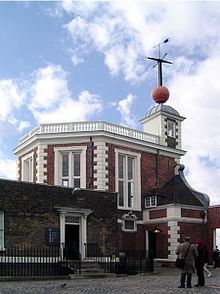Time ball


This file may be deleted after Saturday, 2 June 2012.
A time ball is a large painted wooden or metal ball that drops at a predetermined time, principally to enable sailors to check their marine chronometers from their boats offshore. Accurate timekeeping is one way of enabling mariners to determine their longitude at sea.
History
Time ball stations set their clocks according to transit observations of the positions of the sun and stars. Originally they either had to be stationed at the observatory itself, or had to keep a very accurate clock at the station which was set manually to observatory time. Following the introduction of the electric telegraph around 1850, time balls could be located at a distance from their source of Meantime and operated remotely.
The first time ball was erected at Portsmouth, England in 1829 by its inventor Robert Wauchope, a Captain in the Royal Navy.[2] Others followed in the major ports of the United Kingdom (including Liverpool) and around the maritime world.[2] One was installed in 1833 at the Greenwich Observatory by Astronomer Royal John Pond, and the time ball has dropped at 1 p.m. every day since then.[3] Wauchope submitted his scheme to American and French ambassadors when they visited England.[2] The US Naval Observatory was established in Washington D.C. and the first American time ball went into service in 1845.[2]
Time balls are usually dropped at 1 p.m. (although in the USA they were dropped at noon). They were raised half way about 5 minutes earlier to alert the ships, then with 2–3 minutes to go they were raised the whole way. The time was recorded when the ball began descending, not when it reached the bottom.[4]
With the commencement of radio time signals (in Britain from 1924), time-balls gradually became obsolete and many were demolished in the 1920s.[5]
Time balls around the world
Today there are over sixty time balls standing, though many of these are no longer operational. The existing stations include those at:
- Deal, Kent
- The Old Windmill,_Brisbane, Australia
- Fremantle, Western Australia
- Gdańsk, Poland (The time ball was installed in 1876, moved to the Danzig (now Gdańsk) lighthouse in 1894, and removed in 1929. In 2008 it was reconstructed from original plans)[5]
- Greenwich Observatory
- Clock Tower, Brighton, East Sussex (originally operated hourly, but was later stopped as it was too noisy)[6]
- Nelson's Monument on Calton Hill, Edinburgh
- Point Gellibrand, Victoria
- Sydney Observatory, Australia
- Victoria & Alfred Waterfront, Cape Town
- United States Naval Observatory
- Titanic Memorial, New York
- Citadelle of Quebec, Quebec City
- Semaphore, South Australia
-
Deal Timeball, Deal, UK
-
Gdańsk, Poland
-
Gothenburg, Sweden
-
Clock tower, Brighton, UK
Times Square Ball
A modern variant on the time ball is the ball drop on New Year's Eve, located in Times Square, New York City. Unlike a standard time ball, where the drop starts at exactly noon or 1 p.m., the Times Square drop starts at 11:59:00pm on December 31 and completes sixty seconds later at midnight on January 1. When a leap second was observed at the end of 1987, the drops lasted sixty-one seconds with the countdown being ... 5, 4, 3, 2, 1, Leap Second, Zero.[7] (At the time, the leap second was added at local time; since 1988, leap seconds have been appended worldwide at midnight UTC.)
Lyttelton Timeball Station
The Lyttelton Timeball Station in Lyttelton, New Zealand was operational until it received partial damage in the 2010 Canterbury earthquake. Further severe damage occurred in the February 2011 Christchurch earthquake[8] and a decision was made in March 2011 to dismantle the building due to the danger it posed to the public.[9] The tower collapsed during the major aftershock which hit the Lyttelton area on 13 June 2011.[10]
See also
- Blackhead Point, in Hong Kong, where a time ball was operated from 1908 to 1933
- History of longitude
- Shepherd gate clock
- Time signal
- Weather ball
References
- ^ "Lyttelton Timeball Station, Christchurch". Yahoo! Travel.
- ^ a b c d Aubin, David (2010). The Heavens on Earth: Observatories and Astronomy in Nineteenth-Century Science and Culture. Durham, N.C.: Duke University Press. p. 164. ISBN 978-0-8223-4640-1.
- ^ Greenwich Time Ball Retrieved December 27, 2010
- ^ "Deal Timeball Tower: The Ball Drop". Retrieved 4 January 2009.
- ^ a b "The Gdańsk Nowy Port Lighthouse and Time Ball". Retrieved 4 January 2009.
- ^ "Heritage Gateway Listed Buildings Online — Clock Tower and Attached Railings, North Street (north side), Brighton, Brighton and Hove, East Sussex". Heritage Gateway website. Heritage Gateway (English Heritage, Institute of Historic Building Conservation and ALGAO:England). 2006. Retrieved 2 June 2010.
- ^ McFadden, Robert D. (1987-12-31). "'88 Countdown: 3, 2, 1, Leap Second, 0". New York Times. Retrieved 2 January 2009.
- ^ "New Zealand quake: The epicentre town". BBC News. 25 February 2011.
- ^ Gates, Charlie (4 March 2010). "Timeball Station to be demolished". stuff.co.nz. Retrieved 15 June 2011.
- ^ Greenhill, Marc (14 June 2011-updated). "Workmen unscathed as Timeball Station collapses". stuff.co.nz. Retrieved 15 June 2011.
{{cite news}}: Check date values in:|date=(help)
External links
- "List of Timeballs". Index to the House Documents, Otherwise Publ. as Executive Documents. U.S. Congress. 1876–1877. pp. 305–308.
{{cite book}}: CS1 maint: date format (link) List of time balls worldwide in 1876.
Timeballs on postcards






